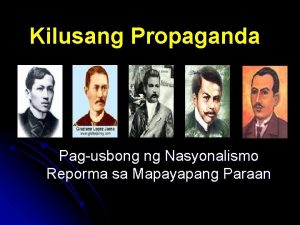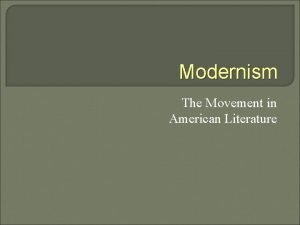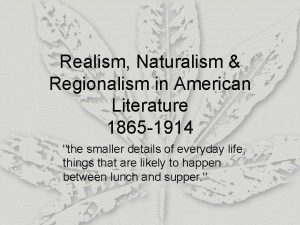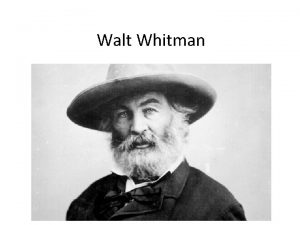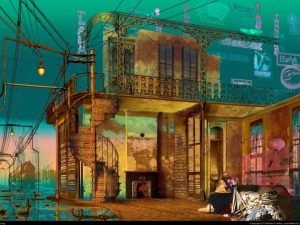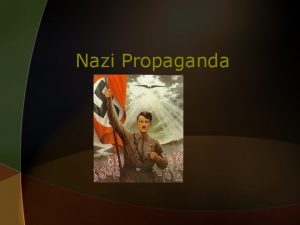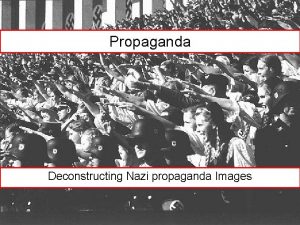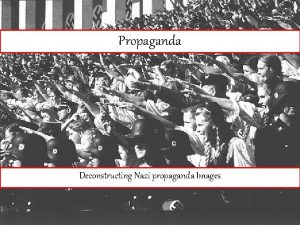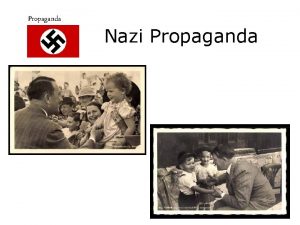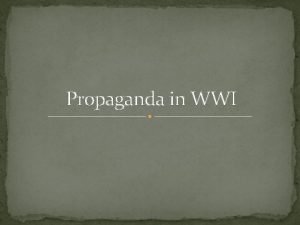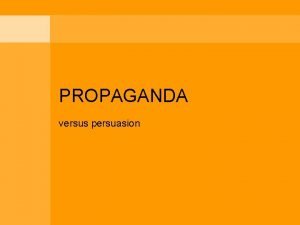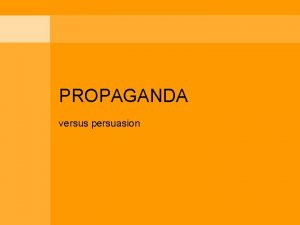Propaganda Movement Propaganda Movement n A literary and





















- Slides: 21

Propaganda Movement

Propaganda Movement n. A literary and cultural organization n 1872 n. Composed of Filipino liberals naimed to increase Spanish awareness of the needs of its colony, the Philippines npropagate a closer relationship between the colony and Spain n. It's prominent members included José Rizal, Graciano Lopez Jaena, Mariano Ponce, Marcelo H. del Pilar.

AIMS: n n n n Representation of the Philippines in the Cortes Generales, the Spanish parliament; Secularization of the clergy; Legalization of Spanish and Filipino equality; Creation of a public school system independent of the friars; Abolition of the polo (labor service) and vandala (forced sale of local products to the government); Guarantee of basic freedoms of speech and association; Equal opportunity for Filipinos and Spanish to enter government service.

KATIPUNAN

THE FOUNDING n night of July 7, 1892 founded along Azcarraga St. (now Claro M. Recto Avenue) near Elcano St. in Tondo, Manila Andres Bonifacio and Teodoro Plata (brother-in-law) and Ladislao Diwa, plus Valentín Díaz and Deodato Arellano

AIMS: to unite Filipinos into one solid nation; n to win Philippine independence by means of an armed conflict (or revolution); n to establish a communist republic after independence. n

ADMINISTRATION Sangguniang Bayan n Sangguniang Balangay n Pangulo; Kalihim; Tagausig; Tagaingat-yaman Pangalawang Pangulo; Pangalawang Kalihim mga kasanguni; Mabalasig; Taliba; Maniningil Tagapamahala ng Basahan ng Bayan; Tagapangasiwa; Manunulat; Tagatulong sa Pagsulat; Tagalaan & Tagalibot. n

LEADERS n 1892 - Arellano (Pangulo) n 1893 - Ramon Basa (Pangulo) n 1894 - Andres Bonifacio (Supremo) He was again elected as officer in 1985

NOTABLE KATIPUNEROS n n n n Emilio Aguinaldo Andrés Bonifacio Gregoria de Jesús Gregorio del Pilar Licerio Gerónimo Emilio Jacinto Vicente Lukban Antonio Luna n n n n Miguel Malvar Macario Sakay Antonio Soliman Manuel Tinio Aurelio Tolentino Jacinto Tolentino Solomon Doma SUPPORTER n Melchora Aquino

SISTEMANG PANTATSULOK n. The founder of the triangle knew the other two members, but the latter did not know each other. n December 1892 - A new system of initiation, modeled after the Masonic rites was then adopted. n Katipon (associate)-Anak ng Bayan n Kawal (soldier)- Gom. Bur. Za n Bayani (patriot)- Rizal n Katipun could graduate to Kawal class by bringing several new members into the society. A Kawal could become a Bayani upon being elected an officer of the society

MEMBERSHIP n Any person who wished to join the Katipunan was subjected to certain initiation rites, resembling those of Masonic rites, to test his courage, patriotism, and loyalty. New recruits underwent the initiation rite three at a time so that no member knew more than two other members of the society.

ADMISSION OF WOMEN TO THE SOCIETY n The first woman to become member of the Katipunan was Gregoria de Jesus, wife of Bonifacio. She was called the Lakambini ng Katipunan (Princess of the Katipunan).

SEEKING RIZAL’S SUPPORT n n Dr. Pío Valenzuela, an old friend of Rizal, to be Katipunan's emissary to Dapitan On June 15, 1896, Dr. Valenzuela left Manila on board of steamer Venus. To camouflage his real mission, he brought with him a blind man named Raymundo Mata and a guide, going to Dapitan to seek Rizal's expert medical service.

n n Valenzuela arrived in Dapitan on June 21 "Huwag, huwag! Iya'y makasasama sa bayang Pilipino!" it was premature, for two reasons: 1. the people are not ready for a massive revolution; and 2. arms and funds must first be collected before raising the cry of revolution. Valenzuela gave another proposal to Rizal: to rescue him. Rizal disapproved with this plan

n n n Instead, Rizal advised Valenzuela to persuade wealthy Filipinos, so that they can solicit funds, where he recommended an elite army officer name Antonio Luna to be Katipunan's war general, if a revolution may break up. "P*#@& i%&*! Saan nalaman ni Rizal na kailangan mo munang magkaroon ng mga armas at barko bago maglunsad ng himagsikan? Saan niya nalaman iyon? ” Later, on Rizal's trial, he will deny that he knew Dr. Pío Valenzuela.

SOLICITING JAPAN’S AID n It was with good reason that the Katipunan solicited Japan's aid and alliance. Japan had been friendly to the Filipino since Spanish colonial era. Many Filipinos who had fled from Spanish persecution had been welcomed there and given full protection of Japanese laws. Bonifacio tried to purchase arms and ammunition from Japan, but failed for lack of funds.

DISCOVERY n On July 5, 1896, Manuél Sityar, a Spanish lieutenant of the guardia civíl stationed at Pasig, reported to Governor-General Ramón Blanco y Erenas the mysterious activities of certain Filipinos who had been gathering arms and recruiting men for some unknown purposes.

n n On August 13, 1896, Fr. Agustín Fernández, an Augustinian curate of San Pedro Makati, wrote to Don Manuél Luengo, Civil Governor of Manila, denouncing anti-Spanish meetings in his parish. The Katipunan was finally discovered by the Spanish authorities six days after Fernández's letter to Luengo.

n n n n August 1896 Teodoro Patiño and Apolonio de la Cruz, Diario de Manila printing press misunderstanding regarding wages Honoria Patiño August 19, 1896 Sor Teresa de Jesus 6: 15 pm that day, Sor Teresa called Teodoro Patiño and advised him to tell everything he knew about the Katipunan through confession to Father Mariano Gíl.

n n n lithographic stone was hidden in the press-room of Diario de Manila. Documents of membership (that uses member’s blood for signing) hidden, together with a picture of Dr. José Rizal and several daggers that was made for the katipunero-employees of the newspaper. Apolonio de la Cruz in possession of a dagger used in Katipunan initiation rites and some list of new accepted members. After the arrest, Father Gíl rushed to Governor-General Blanco to denounce the revolutionary plot of the Katipunan.

THE REVOLUTION n n n Bonifacio called an assembly Kangkong in Balintawak. The meeting took place either on August 23 or August 24 Decided to start the armed uprising and they tore their cedulas The Katipuneros also agreed to attack Manila on August 29.
 Define literary elements
Define literary elements Msgr. pedro palaez
Msgr. pedro palaez Propaganda movement founder
Propaganda movement founder Movement vs non movement area
Movement vs non movement area What is propaganda movement
What is propaganda movement Magdalo pen name
Magdalo pen name Kilusang propaganda meaning
Kilusang propaganda meaning Characteristic of modernism
Characteristic of modernism British literary movements
British literary movements Realism and regionalism in american literature
Realism and regionalism in american literature Literary movement meaning
Literary movement meaning Literary movement timeline
Literary movement timeline Whitman transcendentalism
Whitman transcendentalism Dramatic symbol
Dramatic symbol Regionalism literary movement
Regionalism literary movement What literary movement was nathaniel hawthorne part of
What literary movement was nathaniel hawthorne part of Axial movement?
Axial movement? Romeo and juliet gestures and movement
Romeo and juliet gestures and movement What is loaded words propaganda
What is loaded words propaganda Testimonial propaganda
Testimonial propaganda What does transfer mean in propaganda
What does transfer mean in propaganda Propaganda pros and cons
Propaganda pros and cons






